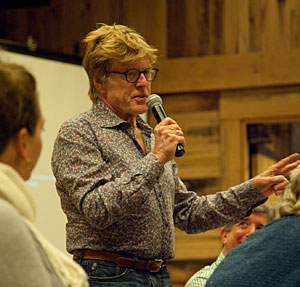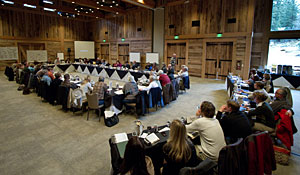The award-winning actor and director Robert Redford has long used his star power to champion environmental, social, and artistic causes. Roughly 40 years ago, he purchased a tract of land Utah’s Wasatch Mountains that would evolve into the 5,000-acre nature preserve and eco-resort known as Sundance. He later established the Sundance Film Festival, Sundance Institute, and the Sundance Channel—all dedicated to supporting independent artists.


Dozens of educators and civic leaders gathered at the Sundance Resort this month for a green schools summit. The event was organized by the Redford Center, USGBC, and ICLEI USA – Local Governments for Sustainability.
Quick Facts
- Of the 133,000 K-12 schools in the U.S., at least 15,000 have air that the EPA qualifies as “unfit to breathe.”
- Schools represent the largest construction sector in the U.S.; $80 billion was spent in 2006 to 2008.
- Green schools use an average of 33 percent less energy and 32 percent less water than conventionally designed schools.
- The average green school saves $100,000 a year on energy costs.
- There currently are 1,728 LEED-registered schools and 343 LEED-certified schools.
Information provided by the USGBC
In 2009, the movie star expanded his enterprise yet again with the official establishment of the Redford Center, a nonprofit that facilitates “positive social and environmental change through the arts, education, and civil discourse.” The organization has delivered on several fronts, from hosting a conference on water conservation to presenting an author series that has drawn eminent figures such as Madeleine Albright and E.O. Wilson.
Now, the organization is getting involved in the sustainable schools movement. From November 7 to 9, dozens of educators and civic leaders from around the U.S. gathered at the Sundance Resort for the first Greening of America’s Schools Summit. The event was organized by the Redford Center with the U.S. Green Building Council (USGBC) and ICLEI USA – Local Governments for Sustainability. The goal: to have a no-holds-barred conversation about greening schools and to develop tools and action plans. The information collected during the summit will be fed into a report that the USGBC and American Institute of Architects plan to co-publish in January.
Attendees stayed at the picturesque resort and spent most of the three-day summit in a barn-like conference room clad in salvaged wood. “Sundance provided the ideal environment for this discussion to take place, with its abundant natural resources and peaceful surroundings,” said Brooks Rainwater, National AIA’s director of local relations, who came from Washington, D.C., for the event. The summit—skillfully moderated by Lee Bycel, the Redford Center’s executive director—drew a broad mix people, including 10 mayors, nine school superintendents, and a number of prominent environmentalists (such as Bill McKibben) and educational association leaders (such as Anne Bryant, executive director of the National School Board Association). Other participants included an architect, chef, and teenager who founded Kids vs Global Warming. Redford said the varied guest list reflects the makeup of our country. "America is diverse," he said. "Diversity is one of our greatest attributes."
The summit was one of the first major events to emerge from the USGBC’s new Center for Green Schools, launched in September. The center intends to organize events, collaborate with educational and environmental organizations, and provide resources and fellowships—all in an effort to boost the number of green schools in the U.S. “We have a very ambitious mission: green schools for everyone in this generation,” said Rachel Gutter, the center’s director. “It’s a very lofty goal, but one we think altogether is worthwhile.” On broader level, Gutter wants to cultivate a generation of “sustainabilty natives”—people who become so accustomed to sustainability in their youth that they regard it as the status quo, not the alternative.
Jordan Howard, a summit attendee, might qualify as a sustainability native. The 18-year-old graduated from the Environmental Charter High School in Los Angeles—an award-winning public school that integrates the environment into its curriculum and campus (think fruit trees, living walls, murals depicting eco-friendly messages). Howard, who is now a freshman at Santa Monica College and aspires to work in education, said she was surprised to hear about the obstacles facing green school proponents. “It’s really amazing learning about the challenges people have endured to have green schools,” she said.
That said, going green is much easier now than in past decades. Redford told attendees that he remembers when people concerned about the environment were “slammed as tree huggers.” Today, environmentalism has become more mainstream, which could bode well for the green school movement. "It feels like to me, in terms of timing, this is the time," he said. "Something is happening."



Post a comment to this article
Report Abusive Comment